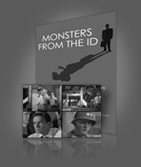Monsters From The ID
Science is Mankind's Last Great Hope
Synopsis
Long Synopsis
The 1950's was an idealistic time in American History, filled with hope, opportunity, and wonder. It was also, "The Atomic Age", where new technology promised to both save humanity as well as put it in jeopardy. All of these factors gave birth to one of the most prolific genres in film history, 1950's Science Fiction Cinema. More then just bug eyed monsters and little green men, 1950's Sci-fi Cinema provided science inspiration for millions of eager youths across the country.
While monsters and invaders of many forms have always existed in cinema, it wasn't until the 1950's that Hollywood created a new character. This new character is the Modern Scientist. His predecessor, the Mad Scientist was evil and intent on using science for his own personal gains, no matter the outcome. With atomic energy now a part of the world everyone lived in, this type of scientist was more dangerous then ever. Instead, the Modern Scientist was created to calm the fears associated with the atomic age. This new American Citizen was brilliant, polite, thoughtful, charming and not surprisingly very good looking. Just as science took the lead in much of the news of the 1950's, the scientist became Hollywood's new leading man and a role model for young boys and girls across America.
Although Hollywood was mostly interested in selling tickets and popcorn, there were others that understood the power of these films and the influence they had on society. Soon filmmakers like Walt Disney and George Pal started collaborating with famed rockets scientists, Werner Von Braun and Willie Ley in an effort to energize the American public and peak their interest in manned space travel. What followed were technically accurate sci-fi films that both entertained and educated the next generation of scientists in America. However as progress marched on, it was a real life event that finally sent the wheels into motion.
On October 4, 1957 the Russians provided the spark in the form of the first man made satellite, Sputnik. America immediately went into a panic and suddenly science and the need to match the Russians in space became a top priority. From that point forward, the American Government took exploratory space flight seriously and the first man they called was Werner Von Braun. With the help of science fairs and a revamped science curriculum an inspired population worked toward one of the greatest achievement of mankind, spaceflight. Along the way, Sci-Fi cinema and science fact worked together to change the lives of American Students in ways we only dreamed of before.
Through the use of the movies themselves and expert analysis from scientists and educators, Monsters From The Id weaves the intersecting themes of over thirty classic films in order to tell the untold story of the Modern Scientist and his role in inspiring a nation. The film continues to explore the psychological and cultural impact of 1950's Sci-Fi cinema and asks, "where is science inspiration found today?"
Director's Statement
When I first started making this film, it began as a love affair with 1950's Sci-Fi cinema. Watching these films as a child there was something so cool about them and amazingly it remained that way as an adult.
At first the documentary was conceived as a montage style genre study. However, after watching over 30 films in their entirety a new theme started to emerge, so I began to research what I was feeling. At first, everything I read was about communism and the fear of atomic power. But, when I watched the films I never felt fear. I always felt hope and excitement and enthusiasm.
I thought this was my own personal bias, until I read Smokin' Rockets and the work of Dr. Lucanio and Gary Coville. Their work validated everything I was feeling in the most eloquent manner. Soon after, I discovered Dr. Dubeck who uses Sci-Fi to teach, and realized that academia was acknowledging the power of the cinema too. Finally it clicked and a hypothesis was formed: 1950's Sci-Fi cinema and the new role of the inspirational scientist influenced America and propelled us into the future. As I learned more, the film transformed from a visual meditation, to a call to action. Then I read the amazing story of a real life self-taught rocket scientist, Homer Hickam and found the answer. As a boy Homer grew up watching Sci-Fi film and was inspired by these new heroes. Homer's inspiration led him to Georgia Tech and eventually a career as a NASA engineer.
However, with all the questions raised, the most important of all is..."now what?" That's what this film seeks. With the number of scientists rapidly disappearing in this country, what effect will this have on jobs and the economy? What effect will it have on the survival of the human race? To combat this trend, could cinema reverse our fate or do we need another sputnik to change the world?
In the film Forbidden Planet viewers were introduced to the Freudian concept of the id, the base sub-conscience of the human mind. Just like Dr. Morbius in the film, all of us must address our own id. In the 1950's, the monsters of the silver screen were physical manifestations of the collective id of the United States. When the monsters were defeated through science and American Ingenuity, it exercised everyone's fears and transcended their emotions into hope. This is what makes these films so great. This is what makes this subject so fascinating and entertaining.
This film recognizes societies monsters in the form of the cinema and puts them on display in the most interesting way I know how. Although science is at the forefront, it is really a film about human nature and how we can rise above it. Ultimately, I hope this film reminds us of all we have accomplished and what we are capable of attaining by addressing our own Monsters From The Id.

